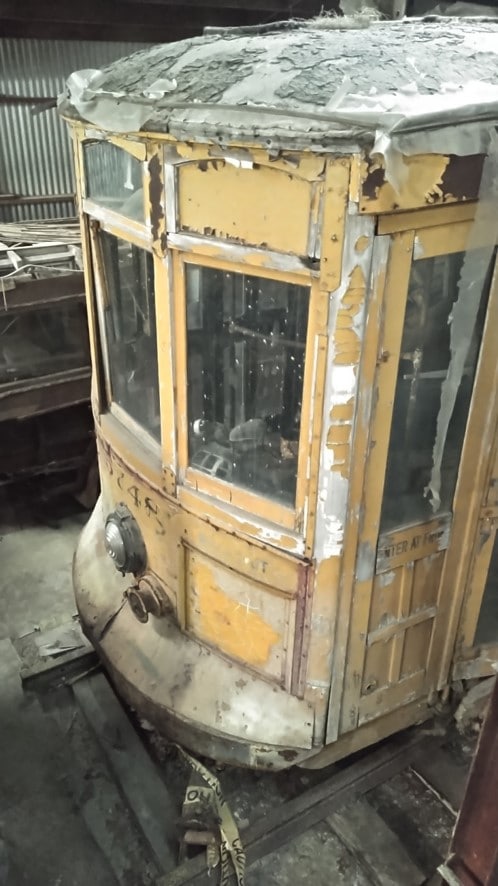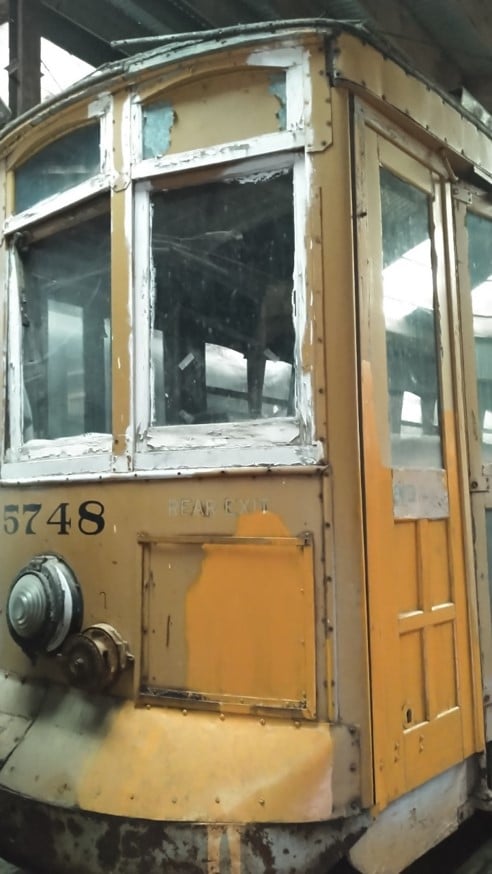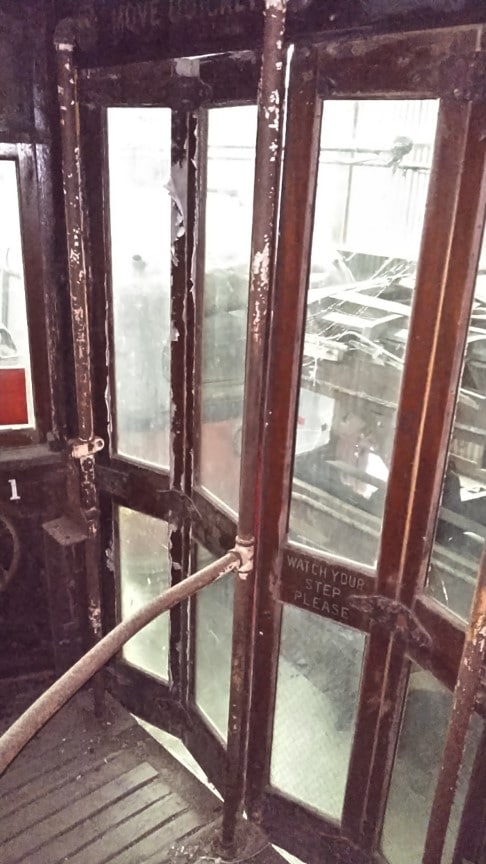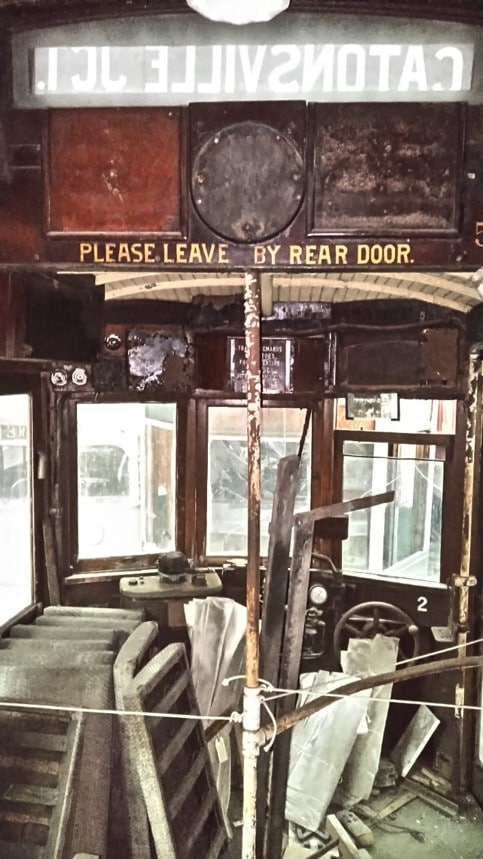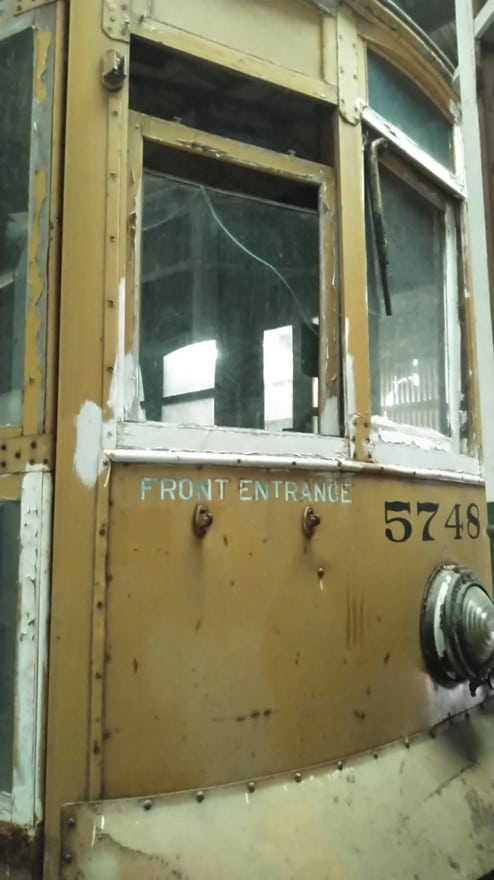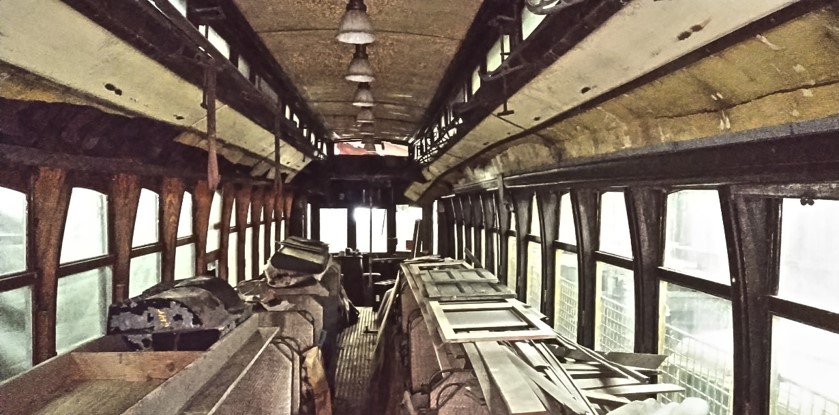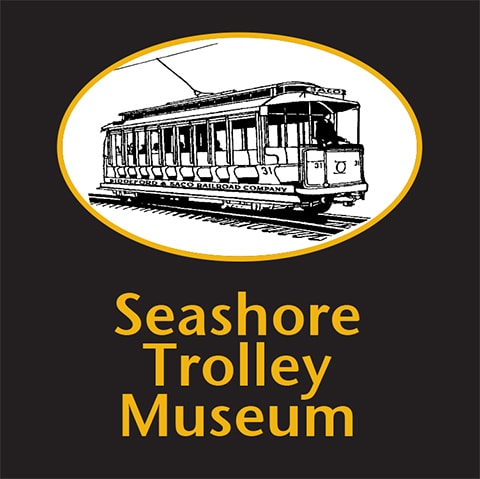Project Sponsors: Fred Maloney, Jim Schantz and Charlie Hughes
Fundraising Goal: $400,000
Questions for our Project Managers? Want to get more involved in the project? Contact them here.
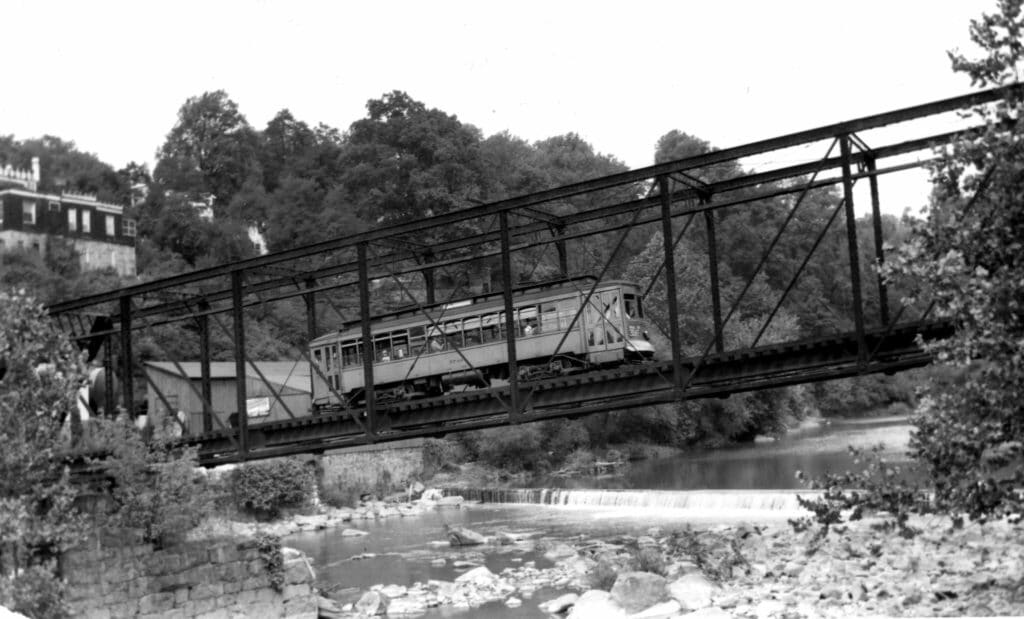
No. 5748 United Railways & Electric Co./Baltimore Transit Co., on Bridge to Ellicott City, Maryland. STM Library Collection
Among the vehicles thoughtfully selected for inclusion in the Society’s New Direction Capital Campaign is classic Baltimore Brill Semi-Convertible car No. 5748. The car was built by J.G. Brill in 1918 for the city’s United Railways & Electric Company. This car is one of the Society’s most important “hidden gems;” tucked away in Central Carhouse for a half-century after initial restoration work began at Seashore ca. 1970. After staff was redirected to work on another urgent operating fleet project years ago, the work on 5748 was suspended and the restoration project never resumed.
No. 5748 holds a very important place in Seashore’s collection. It is the signature preserved Baltimore streetcar; the sole survivor of the massive fleet of 885 mates designed to Baltimore standards and built in a succession of orders with J. G. Brill from 1905 to 1919. This massive fleet dominated Baltimore mass transit for at least 35 years, and the last tiny handful was not retired, including No. 5748, until 1955 – giving the car type an incredible 50 year run!
Substantial work has been performed on this car over the years, but major funding is needed to finish the restoration and make the car operable again. Over the next few years, we will be developing a detailed plan for full restoration and mechanical upgrade, so that the car can live on for decades to come.
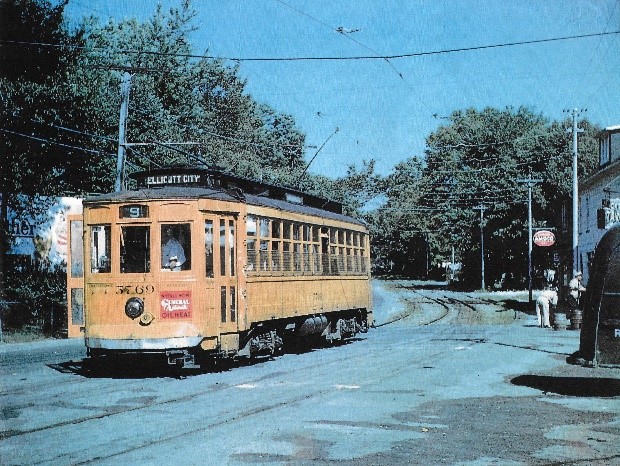
Baltimore Transit 5769 on the Ellicott City line, the last route served by these classic big city streetcars of Brill’s Semi Convertible design. Photo by Jim Schantz.
We have established a $400,000 fundraising goal, with the hope to begin work in the next few years. Those that wish to contribute now may designate your donation to Fund 524.
Your donation will support:
1 – Extensive work on the trucks and motors. The car was received without trucks in 1957. However, as Montreal was winding down street railway operations, Seashore identified their Instruction Car as having appropriate very similar trucks for No. 5748 & arranged for it to be among those to be purchased. The trucks suffer from heavy corrosion caused by the highly corrosive brine solution spread on car tracks in Montreal to melt ice & snow when it is too cold for salt.
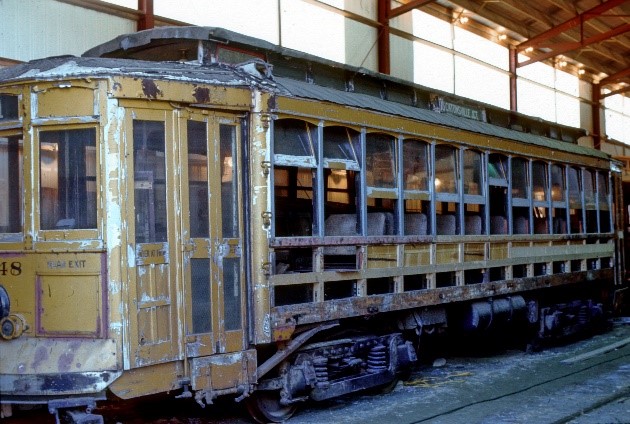
Seashore’s 5748 in the restoration shop having side frame repairs made during an earlier period of restoration work. Photo by Jim Schantz.
2 – Rehabbing one exterior side. The car’s primary structural strength lies in very heavy steel girder plates that run along each side between the bulkheads. When the car was moved around Baltimore following its retirement, the move took place on a very short trailer with one truck hanging from the car completely behind the end of the trailer. The result was very serious damage to the car in that the steel girder plates arched and twisted. During restoration work ca. 1970, one side was dismantled and the girder plate was completely removed, cut apart, flattened and welded together. The plate was returned to place and the side largely reassembled.
3 – Exterior and Interior roof work. Initially, the Museum installed a salvaged large Quonset Hut on the footprint of the present Restoration Shop. We built it to serve as the main shop, but placed 2 closely-spaced tracks in the length of the center to house cars desperately needing covered space ASAP. This included No. 5748 and M&SC freight motor No. 504 and others. The structure collapsed during a mid-week major blizzard with heavy snow. No. 5748, on temporary high trucks, and equally high No. 504 bore the brunt of weight of the collapsed building. Car 504, with its very good condition & straightforward roof style was repaired, No. 5748 was not. The tarpaper roof covering on No. 5748 was not breached, but there is complex damage, visible from inside the car. It may well impact both the upper monitor and lower roof as well.
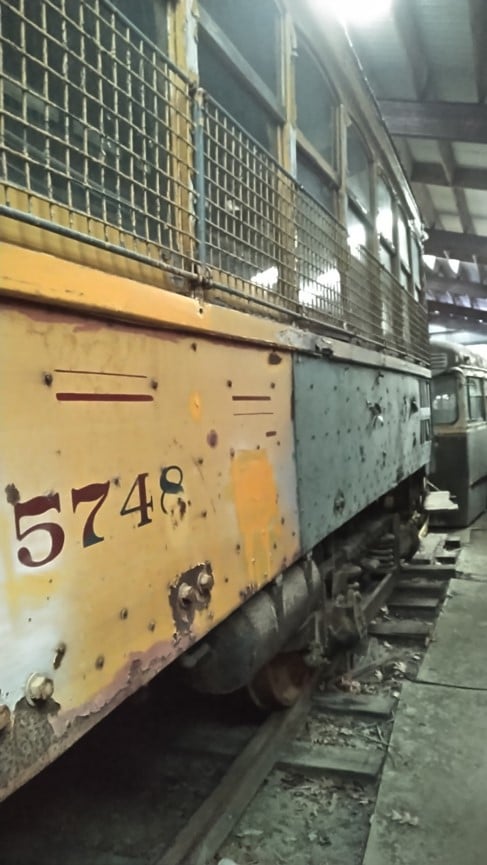
Baltimore 5748 is currently stored in Seashore’s Central Carhouse, awaiting a successful fundraising campaign.
4- New Paint Scheme. No. 5748 will retain its one-person door and operating configuration that was performed by the then-new Baltimore Transit Company in the final phase of its program to convert most Brill semi-convertibles in service (other than the dedicated Sparrows Point fleet) to one-person operation in the 1937 – 1939 period. It will lose the all-yellow paint scheme that was applied in 1949 or 1950. The paint scheme is canary yellow body and letterboard; cream window area; red beltrail; orange striping and black numerals.
And designate your gift to Fund 524
Baltimore Transit History
Baltimore was one of the country’s largest cities throughout the entire street railway era, with a top population of about 950,000 reached in 1950. The infusion of 885 very similar cars into the fleet from 1905 to 1919 had a profound impact upon the street railway in the era that almost all of the population used streetcars for all moving about the city. Very few people had horse & carriage, and it was not until the 1920s that really significant numbers of city people had automobiles. Past authors on Baltimore public transportation estimate that at least 60% of all streetcar riders over the entire life of the first generation electric street railway, from 1890 to 1963 rode on a Brill semi-convertible car! By 1920, “Semi’s” were carrying 80% of the system’s passengers. By the end of the decade, this percentage increased to 95%.
Gradual declines in streetcar riding began in the 1920s, but became drastic during the Great Depression. This came just as 150 semi-streamlined Peter Witt streetcars entered service in 1930, followed by the later infusion of 275 streamlined PCC cars from 1936 – 1944, all resulting in many older Brill “semis” being scrapped in the 1930s. However, the winds of war in Europe resulted in many surplus cars being held in storage for possible future use – and were they used! Earlier, from 1924-1926, some 76 1905-vintage Semis were made into 38 articulated cars, while the same was done to some earlier cars as well. While they provided excess capacity during the Depression, they were extremely valuable during World War II. A significant number of Semis had 40+ year careers, while No. 5748 ran for 37 years.
Low Depression ridership and various fiscal issues resulted in United Railways & Electric Company declaring bankruptcy on January 6, 1933. The company was reorganized and emerged as the Baltimore Transit Company as of July 9, 1935. BTCo expanded bus operation and reintroduced new generation trackless trolleys, but also invested heavily in streamlined PCC streetcars. Most major streetcar lines continued until after World War II.
The National City Lines gained control of the company and the City of Baltimore also hired a new traffic commissioner. NCL was opposed to streetcar plant costs, other than in unique situations where larger, frequent, heavily-loaded, undepreciated streetcars truly helped the balance sheet. Meanwhile, the new traffic commissioner pushed one-way street patterns and also believed that streetcars slowed traffic. Thus, in a decade, only the two heaviest lines, serving four corridors, remained, carrying on until the early hours of November 3, 1963.
As late as 1949-1950 the Semi’s day was not done. A small number of Semis was overhauled and received steel side sheets to give the old cars more body rigidity. They were economically repainted all yellow, with black or tarred roofs and silver bumpers. No. 5748 was included in this final program on these veterans getting “one last boost”. As the street railway shrank, soon after this work was done their remaining use all but ended. By 1954 only a half dozen Semis remained in service, serving 2 shuttle lines to Lorraine Cemetery and Catonsville. In the early hours of June 19, 1955 the final Catonsville car (to which line No. 5748 was assigned) closed out the remarkable 50- year era of these magnificent cars.
Unlike with many cities, the (1963) termination of streetcar service was not the end of the story. New chapters about electric traction were yet to be written.
The continuing presence of a large population, in combination with energetic city and state leadership, were successful in securing substantial Federal funding for a new era of electric rapid transit. Twenty years after the end of traditional streetcar service, in 1983, the first stage of the new Metro Subway was opened. In another decade, in 1993, the first stage of a new light rail system opened. To avoid the very high costs of a new Downtown subway section, in-street car tracks were laid where traditional streetcars had operated many years previously. In the years since, both the subway and the light rail operations have been extended.
About Baltimore 5748
5748 is the signature preserved Baltimore streetcar; the sole survivor of the massive fleet of 885 mates designed to Baltimore standards and built in a succession of orders with J. G. Brill from 1905 to 1919. The first 745 cars were of a shorter length, 2 windows shorter than 13-window cars specified in later orders encompassing cars 5745 – 5885. This gave the later cars – as built – 55 seats and added standing space over the previous 47 seats. Initially cars were built with open platforms, but starting with No. 5560 were fully enclosed. Earlier cars were then retrofitted.
No. 5748 also stands out as the Museum’s best example of a true classic semi-convertible car. In raising the side windows, the lower and upper sash es are interconnected so that both the upper and lower windows glide on tracks extending upwards, sliding between the headlining and the roof. This provides an exceptionally wide open area to maximize the entry of outside air to flow through the car. When introduced this rendered as obsolete the convertible cars, with their need to remove and reinstall large window panels each spring and fall. It also sharply reduced the advantages of open cars in hot summer weather. Open cars had to be stored inside during cold months with corresponding numbers of closed cars in the fleet to replace them. Too, semi-convertible cars held a great advantage for passengers during torrential rain, and random late cold days and early hot days by having windows that could be opened or closed as weather conditions dictated.
The classic Brill semi-convertible car was always seen as having a very high aesthetic appeal in terms of “streetcar architecture.” The high deck roof, arch windows, and overall proportions, including the height and width of the upper roof monitor, the curvature of the roof in relation to the car body, combined with the pleasing car ends, all combine to make for a car that is very pleasing to the eye. The interior detail is also very attractive, with the interior shape detail, attractive varnished cherry wood trim, arch upper windows, rattan seats and brass fittings. This car is a marvelous specimen from the peak era of streetcar development.
Baltimore 5748 Comes to Seashore
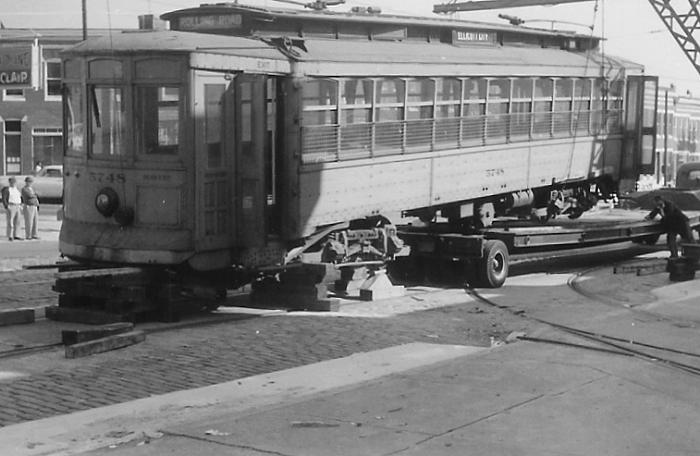
No. 5748 United Railways & Electric Co./Baltimore Transit Co. Being loaded at Closed Edmondson Car Shop on Trailer Bound for Seashore Trolley Museum. Jerry Kelly Collection, newdavesrailpix
The Museum already had an established relationship with the Baltimore Transit Company, which had very kindly donated Peter Witt car No. 6144. However, the strategic retirement of a key official resulted in our request letter for a Brill semi-convertible to disappear, and not get acted upon as the final batch of cars was sold for scrap. But two years later the Maryland Historical Society, which held the historic Baltimore streetcar collection and had come to include No. 5748, offered Seashore this car, less trucks; sold for scrap to help pay for streetcar moving costs. The collection had to be moved to Baltimore’s city sanitation truck garage, which lacked space for this car, pending planning for creation of the body that became the Baltimore Streetcar Museum. This splendid collection had been assembled over several decades by wonderful foresight by the United Railways & Electric Company, and continued under the Baltimore Transit Company. But, by 1957 the size of the streetcar system physical plant was in steep decline; spare carhouse space was being sold off, and the Maryland Historical Society took possession of the collection, and had to remove the cars from the transit system. A major disincentive to retain No. 5748 may have also been that the car had become considerably damaged in a local area trucking move of the car.
Seashore moved No. 5748 to the Museum in 1957. In 1958-1959, as Montreal’s streetcar system was being shut down, Seashore assembled a large request to purchase cars for preservation, cars for parts and spare parts as well. This included the instruction car having proper Brill trucks for No. 5748.
As noted above, No. 5748 was seriously damaged in a local trucking move prior to our acquiring the car. The car body had become arched and twisted. While the serious damage likely influenced disposal of the car by Baltimore decision makers, Seashore had long realized the centrality of carrying out its preservation mission necessitated developing a restoration shop with skills to undertake major car rehabilitation work. The heavy work needed by No. 5748 was not a deterrent to acquisition.
Soon after arrival volunteers covered the roof with tarpaper. Later, non-appropriate interurban trucks acquired from Springfield Terminal Railway enabled retrucking of the car. Afterwards, the car then gained inside storage.
A few years later, generous activist member donors contributed funds to begin the restoration of the car. All lower side windows were rebuilt, and one damaged side was dismantled, the main heavy girder beam was heavily reworked and straightened, and the side reassembled. After restoration work on the car was suspended, the following 50 years the car has always been tucked away inside a carhouse, awaiting resumption of restoration work.
Significance of 5748 in Seashore’s National Collection of American Streetcars
The only preserved Baltimore streetcars to exist, outside of the historic collection at our colleague Baltimore Streetcar Museum, are the two cars at Seashore. They include Brill semi-convertible No. 5748 of 1918, and Brill semi-streamlined Peter Witt No. 6144 of 1930.
Baltimore was a very large and nationally vital ocean shipping and manufacturing city for the entire duration of the primary traction era. This ran from the 1890s until post-World War II suburbanization diminished the primacy of many cities.
Baltimore also had a very long-running traditional first generation street railway system, in operation from 1859 until 1963. And, the city has since built a new subway, as well as a light rail system. This includes new in-street car tracks in the heart of the city, precisely where convoys of traditional streetcars had previously run for generations.
The Seashore collection is unique in having a signature streetcar from essentially every city of first-tier standing during the primary street railway era. Over time some have been restored, while others await donors and restoration staff availability.
No. 5748 has particular stature. Not only is it the sole signature Baltimore streetcar in existence, but the car is the purest example of a semi-convertible car in the Seashore collection, and about the best example of this car type anywhere.
No. 5748 is a splendid example of the farsighted vision of Museum collection development leaders of the 1950s, who saw the wisdom of rescuing this distorted and worn car lacking trucks in a relatively distant city. It was moved to Maine in an atmosphere of dozens of old streetcars in open storage in a large field. How far we have come!
United Railways & Electric Company Car Numbering System
During the period of discussion, the system employed an unusual car numbering system whereby the first one or two digits identified the assigned route for each car, Routes 1-9 had 3-digit car numbers, while 10 and above had 4-digit car numbers.
This system was intricate, whereby any car shifted to a different line had to be renumbered + all shop and carhouse maintenance records required revision as well.
As a matter of information, the Museum’s Brill semi-convertible arrived from the J. G. Brill plant as car No. 1504 – a Route 15 car.
In 1922 the company commenced renumbering all cars into series. The Brill semi-convertible fleet was renumbered as 5001-5884; one car having been destroyed by fire in 1921, before the fleet revision was undertaken.
A Few Fleet Modifications
Over half of the semi-convertible fleet arrived with open platforms. Starting with car No. 5560, cars were ordered with fully enclosed platforms with doors. Earlier cars were then rebuilt with new (+ in the case of the earliest cars) extended platforms which were fully enclosed and equipped with uniform doors.
Starting with No 5745, the cars were built longer at 46’7”, as opposed to 42’4”, and had 2 added windows (13) and 2 additional rows of cross seats. The windows on the longer cars were slightly narrower, as was the seat spacing in these cars.
Various groups of later Semis were initially equipped to run in multiple-unit (MU) trains of 2 or 3 cars, while some groups of earlier cars were later retrofitted. The only regular MU service was operated on the Sparrows Point line where a huge Bethlehem Steel plant was located, and where nearby beaches drew crowds on weekends. Three-car trains (sometimes including a center-entrance trailer) were much less operated, in that operational constrictions limited such runs only from Highlandtown outward, whereas 2-car trains went Downtown. Two-car trains operated on this line until the line became 100% PCC car operated ca. 1952.
Sparrows Point Semis were always conductor-staffed rear door entry cars, by some years the last conductor staffed vehicles on the system. While red & cream cars were traditionally recognized as rear entrance cars, as this operation became the only such line in the system, confusion emerged. Accordingly, large stenciled signs with arrows were applied on Sparrows Point Semis directing passengers to board at rear doors. Too, all Semis rehabbed in 1949 & 1950 were simply painted all- yellow with large directional signs on the conductor-staffed cars, Theses 2-man cars were some of the last 2-person streetcars in the country by the time they were displaced, other than in New Orleans and Philadelphia, where conductors were used considerably later.
The most radical semi revamp was done from 1924-1926 when 76 early vintage cars were rebuilt into 38 articulated cars, renumbered into the 8100 series. Over 50 cars were also converted into single-end cars during the 1930s.
Otherwise, the semi-convertible fleet was largely converted to one-man operation through the 1930s. No. 5748 was in the final batches of cars to be revamped. They were painted canary yellow and cream with a red beltrail. This color scheme signified boarding the car by the front doors, while red and cream cars continued to be boarded at the rear doors. Montreal also employed different colors to instantly identify at which doors to board. The chief change to converting cars to one-man operation was that the one-man cars had the double-stream doors moved to the front the single-stream doors and the accompanying stationary flat panel moved to the rear. Of course there were other less obvious internal alterations.
Track Gauge
Baltimore’s traditional gauge of 5’4 ½” is the widest in the country. It was mandated as the initial horse car lines were approved in 1859 to facilitate wagons, which tended to have this wheel spacing, to run in the tracks rather than on the uneven cobblestones of the day. Given that fact it is surprising that other cities didn’t mandate this gauge. Some cities mandated different gauges to prevent railroad trains from operating in city streets. All current rail transit in Baltimore uses standard gauge of 4’ 8 1/2”. The Baltimore Streetcar collection is of the traditional Baltimore gauge, so the museum preserves the iconic gauge.
Want to learn even more about Baltimore Streetcars? We suggest “Baltimore Streetcars 1905-1963: The Semi-Convertible Era” by Bernard J. Sachs, George F. Nixon and Harold E. Cox, published in 1982. The authors all “lived it”, and its 139 pages and its several sheet errata supplement are loaded with all facets of detail on Brill semi-convertibles and all the streetcars that followed them. Most of the information shared above was derived from this source.
And designate your gift to Fund 524
More Photos of Baltimore 5748 to demonstrate its current condition, and the need for funds so we can complete the restoration.
